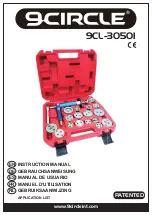
V1.0
Short Barrel Air Hammer
8843575
Visit www.princessauto.com for more information
7
7.
Never touch the tool accessory or workpiece during or immediately
after use. They may be hot and could inflict a burn injury.
8. Never use a tool with a cracked or worn tool accessory. Change the
tool accessory before using it.
9.
Do not place the tool down until the tool’s accessory has stopped moving.
The accessory may catch the surface of work material and wrench itself
free, causing injury to the user or others in the work area.
10. The tool is not insulated against contact with live electrical conduits or
sources. The tool’s exposed metal surfaces may convey a shock to the
operator from a ‘live’ wire.
11. Gum and wood pitch hardened on an accessory slows the tool and
increases the potential for kickback. Remove the accessory from the
tool, then clean it with gum and pitch remover, hot water or kerosene.
Never use gasoline. Allow to dry before use. Discard the accessory if
the gum or pitch cannot be removed.
AIR HOSE PRECAUTIONS
1.
Inspect the tool's air hose for cracks, fraying or other faults before
each use. Discontinue use if the air hose is damaged or hissing is heard
from the air hose or couplers. Replace the defective air hose.
2. Do not allow people, mobile equipment or vehicles to pass over the
unprotected air hose. Position the air hose away from high traffic
areas, in a reinforced conduit or place planks on both sides of the air
hose to create a protective trench.
3.
Prevent damage to the air hose by observing the following:
a.
Never carry the tool by the air hose.
b.
Keep the air hose behind the tool and out of the tool's work path.
c.
Keep the air hose away from heat, oil, sharp edges or moving parts.
d. Do not wrap the air hose around the tool as sharp edges may
pierce or crack the air hose. Gently coil the hose and either hang
on a hook or fasten with a device to keep hose together when
storing.
4.
A damaged or disconnected air hose under pressure may whip around
and inflict personal injury or damage the work area. Secure the
compressor's air hose to a fixed or permanent structure with clamps or
cable ties.








































